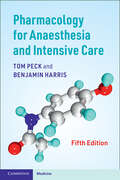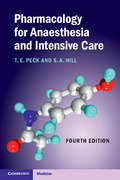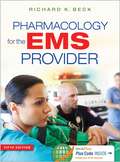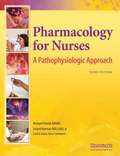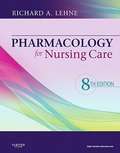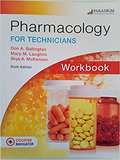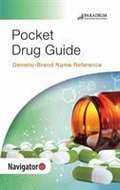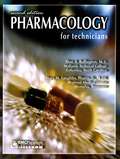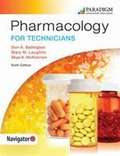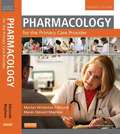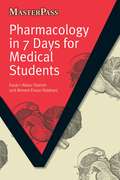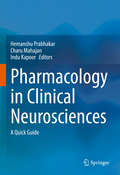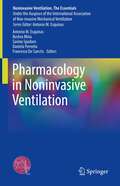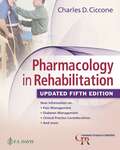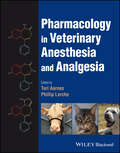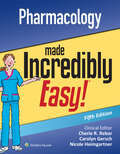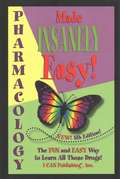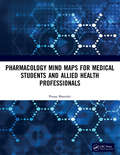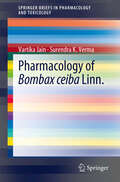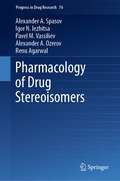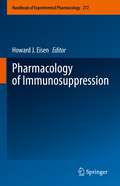- Table View
- List View
Pharmacology for Anaesthesia and Intensive Care
by Tom Peck Benjamin HarrisThe fifth edition of this popular textbook continues to provide a solid foundation of pharmacological knowledge for all those working in anaesthesia and intensive care. The content has been thoroughly revised to include expanded chapters with clearer figures, ensuring readers are kept abreast of the ever-changing landscape of clinical pharmacology. Conveniently divided into four sections covering the basic principles of pharmacology, core drugs in anaesthetic practice, cardiovascular drugs, and other important drugs and complemented by new diagrams, tables and chemical formulae to facilitate learning. All four chapters on core drugs in anaesthetic practice have been updated along with others exploring applied pharmacokinetic models, antimicrobials, and drugs used in diabetes. An ideal aid to study and practice for junior and trainee anaesthetists and intensive care specialists preparing for exams. Also an invaluable resource for theatre practitioners, ICU nurses and physicians working in areas that demand a solid knowledge of pharmacology.
Pharmacology for Anaesthesia and Intensive Care
by Tom Peck Sue Hill Mark Williams Tom Peck Sue HillThe third edition of this market leading book has been thoroughly updated and expanded, with additional contributions from experts in the field, to include all new drugs available to the anaesthetist and intensive care specialist. Basic pharmacological principles, vital to understanding how individual drugs actually have their effects, are dealt with methodically and with many highly annotated diagrams and tables. With hospital infections becoming increasingly prevalent, the important section on antibiotics has been further expanded. With the third edition, this well established title continues to provide its readers with the most concise yet comprehensive coverage of all aspects of pharmacology. An ideal aid to study and practice for junior and trainee anaesthetists, critical care nurses and all physicians and healthcare professionals working in theatre, accident and emergency departments or intensive care units.
Pharmacology for Anaesthesia and Intensive Care (4th Edition)
by T. E. Peck S. A. HillThe fourth edition of this market leading anaesthetic book has been fully updated to include novel oral anticoagulants and neuromuscular reversal agents. Numerous other sections have been expanded or updated to reflect new research and current best practice, and the antibiotics chapter now includes information about commonly encountered pathogens and the drugs used to target them. Basic pharmacological principles, vital to understanding the effects of individual drugs, are dealt with methodically, and the essential physiology is described alongside the relevant pharmacology. This has become the core pharmacology book for the FRCA, covering all the relevant kinetics and dynamics in a compact and easy to navigate format, including clear diagrams and tables. This is an ideal aid to study and practice for junior and trainee anaesthetists. Theatre practitioners, ICU nurses and physicians working in areas that demand a solid foundation of pharmacological knowledge will also find this an invaluable resource.
Pharmacology For The EMS Provider (Fifth Edition)
by Richard K. BeckDesigned for learning success. Overcome your fears and build your confidence while you master the mathematic and pharmacology knowledge you need to pass your licensure exams and prepare for professional practice. The 5th Edition of this popular resource presents often complex information is an way that's easy to understand and easy to follow, emphasizing the relevance of the drug information to your work as a paramedic as well as the calculations required to safely administer the correct drug dosages. Access more online. Redeem the Plus Code inside new, printed texts to access a wealth of resources online at DavisPlus. You'll find your Davis Digital Version, your complete text online, study questions, and fifteen animated learning modules that show you how drugs work. "Good book. " "This book is VERY helpful! I found that it breaks the math down and makes it very simple and easy to follow! I recommend this book to anyone going through Paramedic School!"--Kimberly Wright, review of a previous edition
Pharmacology for Nurses: A Pathophysiologic Approach (3rd Edition)
by Michael Patrick Adams Leland Norman Holland Jr. Carol Q. UrbanThe third edition of Pharmacology for Nurses: A Pathophysiologic Approach has been thoroughly updated to reflect current pharmacologic drugs and processes. This book is structured to present pharmacology and pathology together, so students can more easily grasp the interrelationship between these subjects and patient care.
Pharmacology For Nursing Care
by Richard A. LehneA favorite among nursing students, Pharmacology for Nursing Care, 8th Edition, features a uniquely engaging writing style, clear explanations, and unmatched clinical precision and currency to help you gain a solid understanding of key drugs and their implications -- as opposed to just memorization of certain facts. Compelling features such as a drug prototype approach, use of large and small print to distinguish need-to-know versus nice-to-know content, and a focus on major nursing implications save you study time by directing your attention on the most important, need-to-know information. The new edition also features an abundance of content updates to keep you ahead of the curve in school and in professional practice. UNIQUE! Engaging writing style with clear explanations makes content easy to grasp and even enjoyable to learn. A drug prototype approach uses one drug within each drug family to characterize all members of its group to help you learn about related drugs currently on the market and drugs that will be released once you begin practice. UNIQUE! Special Interest Topic boxes address timely issues in pharmacology and connect pharmacology content with current trends. Large print/small print design distinguishes essential "need-to-know" information from "nice-to-know" information. Limited discussion of adverse effects and drug interactions keeps your limited study time focused on only the most clinically important information. Reliance on up-to-date evidence-based clinical guidelines ensures that therapeutic uses are clinically relevant. Integrated and summarized nursing content demonstrates the vital interplay between drug therapy and nursing care. Coverage of dietary supplements and herbal interactions equips you to alert patients and caregivers to the potential dangers of certain dietary supplements, including interactions with prescribed and over-the-counter drugs and herbal therapies. Additional learning features provide a touchstone for study and review as you complete reading assignments and build a foundation of pharmacologic knowledge. Updated drug content and related nursing content reflect the very latest FDA drug approvals, withdrawals, and evidence-based therapeutic uses. Expanded and updated content on medication safety prepares you to pass the NCLEX Examination and practice safe medication administration in the clinical setting. Expanded coverage of pharmacogenomics introduces you to the many different genetic factors that influence drug therapy
Pharmacology for Technicians: Workbook (6th Edition)
by Don A. Ballington Mary M. Laughlin Skye McKennonAs the most in-depth pharmacology text designed specifically for pharmacy technicians, this title prepares students for a career in community, institutional, and other pharmacy settings. Students will develop a basic understanding of drug classes and the mechanisms of action for many drugs. They will also gain insight into why certain drugs are prescribed for particular disease states and obtain instruction for making informed, intelligent decisions when dispensing drugs. Includes an all-new drug guide and workbook, available in print or digitally.
Pharmacology For Technicians: Paradigm's Pocket Drug Guide
by Don A. Ballington Mary M. Laughlin Skye McKennon<P>As the most in-depth pharmacology text designed specifically for pharmacy technicians, this title prepares students for a career in community, institutional, and other pharmacy settings.<P> Students will develop a basic understanding of drug classes and the mechanisms of action for many drugs. <P>They will also gain insight into why certain drugs are prescribed for particular disease states and obtain instruction for making informed, intelligent decisions when dispensing drugs.<P> Includes an all-new drug guide and workbook, available in print or digitally.
Pharmacology for Technicians (2nd edition)
by Don A. Ballington Mary M. LaughlinThis second edition offers updated discussion of drug actions and interactions, and expanded treatment of generic drugs, the drug approval process, and pharmacokinetics. Internet research exercises are also new to this edition. Ballington is program coordinator for the pharmacy technician training program at Midlands Technical College (Columbia, South Carolina); Laughlin is affiliated with the Regional Medical Center in Memphis, Tennessee and the U. of Tennessee.
Pharmacology for Technicians (6th Edition)
by Don A. Ballington Mary M. Laughlin Skye McKennonAs the most in-depth pharmacology text designed specifically for pharmacy technicians, this title prepares students for a career in community, institutional, and other pharmacy settings. Students will develop a basic understanding of drug classes and the mechanisms of action for many drugs. They will also gain insight into why certain drugs are prescribed for particular disease states and obtain instruction for making informed, intelligent decisions when dispensing drugs. Includes an all-new drug guide and workbook, available in print or digitally.
Pharmacology for Technicians (Second Edition)
by Don A. Ballington Mary M. LaughlinThis second edition offers updated discussion of drug actions and interactions, and expanded treatment of generic drugs, the drug approval process, and pharmacokinetics. Internet research exercises are also new to this edition. Ballington is program coordinator for the pharmacy technician training program at Midlands Technical College (Columbia, South Carolina); Laughlin is affiliated with the Regional Medical Center in Memphis, Tennessee and the U. of Tennessee.
Pharmacology for Technicians Workbook
by Don A. Ballington Mary M. LaughlinText introducing the action mechanisms of drugs and their dispensatory requirements. Basic pharmaceutical concepts and techniques are covered.
Pharmacology for the Primary Care Provider, Fourth Edition
by Marilyn Winterton Edmunds Maren Stewart Mayhew Stephen M. SetterWritten by and for nurse practitioners, and also suitable for physician's assistants, this edition focuses on what you need to know to safely and effectively prescribe drugs for primary care.
Pharmacology in 7 Days for Medical Students (MasterPass)
by Fazal-I-Akbar Danish Ahmed Ehsan RabbaniPharmacological knowledge among medical students can have a very short 'half life': students often fail not because they have failed to study, but because they have been unable to retain key knowledge and reproduce it in an exam setting. This book takes an alternative route to the conventional approach of comprehensively exploring each individual drug and its features: not only can such an approach overwhelm and make knowledge retention difficult, but the current exam format makes questions structured in this way unlikely anyway. Instead of aiming to be completely comprehensive, it examines drugs systematically by classifications, mechanisms of action, therapeutic uses and side effects, enabling students to gain the distilled, functional grasp of pharmacology that their exams actually demand quickly and clearly.
Pharmacology in Clinical Neurosciences: A Quick Guide
by Hemanshu Prabhakar Charu Mahajan Indu KapoorThe pharmacodynamics and pharmacokinetics of several drugs is expected to be known to clinicians and researchers at all times. With advances in sciences and development of newer drugs very frequently, it is very important to keep your knowledge updated at all times. This title is a quick guide to researchers and clinicians for a quick reference. The title is also a vital resource for all streams of neurosciences (neuroanesthesia and neurointensive care) and is much different from a conventional pharmacology titles, being more reader friendly and to the point facilitated with numerous flowcharts and algorithms with each chapter being prepared in a standard structured manner.
Pharmacology in Noninvasive Ventilation (Noninvasive Ventilation. The Essentials)
by Antonio M. Esquinas Bushra Mina Savino Spadaro Daniela Perrotta Francesco De SanctisThis book presents the best practice, indications and drugs most used in the practice of noninvasive ventilation (NIV). In the last two decades NIV has made a lot of progress in different scenarios and etiologies of respiratory failure. The treatment of these patients frequently involves the use of drugs to control patient's symptoms such as dyspnea, discomfort and some of them can have direct or indirect effects on lung function. The volume is organized into various sections - dedicated both to adults as well as pediatrics - where the most frequent clinical conditions requiring for the use of a pharmacological support are described. Furthermore, this book is conceived as a quick reference guide including an analysis of the indications of drugs dosage and the pharmacological interactions that can be observed in lung function in patients undergoing NIV. Thanks to its contents, readers can quickly consult indications, contraindications, doses, the most suitable treatments to achieve the maximum NIV as well as the most important side effects reported by clinicians. In this book specialists in critical care and pharmacology, managing both adult and pediatric population, shed a light to the proper medication management and best drugs choice in patients with indications for NIV
Pharmacology in Rehabilitation
by Charles D. CicconeBring your understanding of the rapidly evolving world of pharmacological agents and their impact on rehabilitation up to date with the Updated 5th Edition of this groundbreaking reference. An easy-to-understand writing style and easy-to-follow design help you to understand the what, why, and how of this complex subject to ensure the most effective plans of care for your patients.
Pharmacology in Veterinary Anesthesia and Analgesia
by Turi Aarnes Phillip LerchePharmacology in Veterinary Anesthesia and Analgesia A concise yet comprehensive and usable pharmacological resource for veterinary practitioners In Pharmacology in Veterinary Anesthesia and Analgesia, a team of distinguished veterinary practitioners delivers a singular and comprehensive text dedicated to anesthetic drug pharmacology and drug interactions related specifically to anesthetic drugs in a veterinary setting. This concise, easily navigable reference combines information scattered throughout the academic literature and covers mechanisms of action of commonly used drugs in commonly encountered species, drug interactions, and clinical uses of anesthetic drugs. The volume explores drug metabolism, the effects of various drugs on organ systems, risks of adverse effects, as well as the impact of anesthesia on drugs, and the effects of drugs on anesthesia. Readers will also find: A thorough introduction to pharmacokinetics, pharmacodynamics, and pharmacogenomics in veterinary anesthesia Comprehensive explorations of veterinary regulatory concerns associated with anesthesia and analgesia for food animals Practical discussions of alpha-2 agonists and antagonists, phenothiazines, butyrophenones, benzodiazepines, and opioid agonists and antagonists Fulsome treatments of local anesthetics, non-steroidal anti-inflammatory drugs, inhalants, and induction drugs Perfect for veterinary anesthesiologists and criticalists, internists, and surgeons, Pharmacology in Veterinary Anesthesia and Analgesia will also earn a place in the libraries of private practitioners and veterinary technicians performing anesthesia as well as researchers using veterinary species as a model.
Pharmacology Made Incredibly Easy (Incredibly Easy! Series®)
by Cherie R. Rebar Nicole M. Heimgartner Carolyn GerschReady to master the medication process? Tap into the go-to resource for nursing pharmacology basics, with the fully updated new fifth edition of Pharmacology Made Incredibly Easy!®.Offering clear, concise descriptions of crucial nursing pharmacology concepts and procedures, this easy-to-follow, colorfully illustrated guide offers step-by-step guidance so to can grasp the fundamentals in enjoyable Incredibly Easy style. From initial assessment to safe medication administration and patient care plans, this is the perfect supplement to class materials, offering solid preparation for NCLEX®, as well as a handy refresher for experienced nurses.
Pharmacology Made Insanely Easy!
by Loretta Manning Sylvia RayfieldThey bring you the book you've been “SCREAMING” for ... Pharmacology Made Insanely Easy! With over 1,150 drugs and alternative meds represented by only 245 images. Pharmacology Made Insanely Easy! will be an awesome learning tool utilizing the same GREAT methods you found in Nursing Made Insanely Easy! <P><P> The biggest difference is that this book will be useful for learners in pharmacology, pharmacy tech, medicine, physical therapy, physicians assistants, nurse practitioners, international nurses preparing for the CGFNS Qualifying Exam, nursing students of all medical and allied health programs or anyone needing a way to remember “all those drugs”. Carry this book with you throughout your career as a useful reference.
Pharmacology Mind Maps for Medical Students and Allied Health Professionals
by Prasan BhandariPharmacology Mind Maps is meant as a concise companion for the pharmacology students, enabling them to revise the subject in a short time through the innovative and effective technique of mind maps, after understanding the subject from a standard reference textbook. This handy manual provides the subject information in a condensed form, helping in last minute revision. Mind mapping is slowly taking over traditional methods and techniques and is explored extensively for a subject like pharmacology which is both an essential as well as a difficult subject to master for a medical student. This book will thus help the students to read, revise and recollect the subject easily and rapidly.
Pharmacology of Bombax ceiba Linn.
by Vartika Jain Surendra K. VermaThis work is the first monograph devoted solely to Bombax ceiba, popularly known as the Red Silk Cotton Tree. Consisting of seven chapters, it covers all relevant aspects of this plant, from its historical and spiritual importance, to its botanical characterization, pharmacognostical details and ethnobiological uses, to its scientific validation in various animal and human studies. Each part of the tree is of medicinal value and possesses many novel chemical constituents such as shamimicin, bombasin, bombamalone, bombamaloside etc. along with other bioactive secondary metabolites. The book presents the chemical structures of the most important constituents and highlights various pharmacological activities, predominantly antioxidant, anti-inflammatory, anti-mutagenic, hypoglycemic, hypotensive, hepatoprotective and fibrinolytic, which may prove to be a source for the development of a novel phyto-pharmaceutical agent to treat diabetes, heart disease and cancer. In addition, separate chapters deal with the commercial and ecological significance of B. ceiba, as well as a case study on its conservation. Numerous color illustrations are included to identify the plant and to justify its nickname, the "Little Bird's Cafeteria".
Pharmacology of Drug Stereoisomers (Progress in Drug Research #76)
by Alexander A. Spasov Igor N. Iezhitsa Pavel M. Vassiliev Alexander A. Ozerov Renu AgarwalThe book is devoted to an important aspect of pharmacology and pharmaceutical chemistry, i.e. the significance of stereoisomerism of drugs for their biological effect from the point of view of their pharmacokinetics, pharmacodynamics and toxicology. The authors review the landmarks in the development of stereochemistry and stereopharmacology. Present-day IUPAC terminology is discussed; general issues of stereoisomerism are considered including separation of racemic mixtures and asymmetric synthesis of isomers, methods of quantifying the isomers of a drug in biological material. The authors put special emphasis on general problems of the influence of stereoisomerism on pharmacological and adverse effects of drugs. A classification of drugs based on stereochemical properties of their isomers is proposed. Possibilities of interaction of stereoisomers in racemic mixtures are discussed. A considerable portion of the book is devoted to pharmacological action of the main groups of drugs whose structure includes asymmetric atoms (that is, drugs with several isomers). Detailed attention is paid to advisability of developing single isomer drugs and to the specifics of their study at the stage of preclinical and clinical trials.
Pharmacology of Immunosuppression (Handbook of Experimental Pharmacology #272)
by Howard J. EisenThe goal of this book is to provide a guide and detailed review of immunosuppression in terms of molecular mechanisms of action, side effects and clinical trials that validated their utility. This includes their use in solid organ transplantation, bone marrow transplantation and autoimmune diseases and inflammatory diseases. This book is a critical review of these topics and a vital resource.
